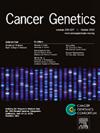宫颈癌前病变BRCA1基因多态性与hrHPV感染的相关性研究
IF 2.1
4区 医学
Q4 GENETICS & HEREDITY
引用次数: 0
摘要
宫颈鳞状上皮内病变是由人乳头瘤病毒(HPV)的高危亚型引起的癌前病变。这些病变的发展和预后可能受到宿主遗传的影响。采用Sanger测序法对脱落宫颈细胞的乳腺癌易感基因(BRCA1)外显子进行测序。在BRCA1的整个外显子中鉴定出15个单核苷酸多态性(snp)。结果发现错义突变8个,无义突变1个,同义突变4个,非蛋白编码区突变2个。使用polyphen2、ESEFinder3.0和SIFT在线软件对BRCA1错义和同义突变位点进行功能预测。通过测序发现BRCA1基因的rs39812263突变具有显著性差异。BRCA1基因rs398122630在hrHPV和薄壁细胞学检查(TCT)组之间的改变有显著差异(p <;0.05), hrHPV与TCT呈负相关。BRCA1基因rs398122630的基因型和等位基因频率与对照组差异有统计学意义(p <;0.05)。Rs398122630可能在宫颈癌的进展中起保护作用。这个位点是一个无义突变,可能导致蛋白质翻译的过早终止。随后,我们查询基因表达图谱(Gene Expression Omnibus, GEO),发现BRCA1基因RNA在宫颈正常上皮、宫颈高级别上皮内瘤变(CIN)和宫颈鳞状细胞癌(CSCC)中表达逐渐升高。利用慢病毒载体构建BRCA1(乳腺癌易感基因1)敲除和过表达的稳定细胞系。BRCA1基因敲除的HeLa细胞划痕愈合率显著高于阴性对照组(P <;0.05),而过表达组的抓痕愈合率差异无统计学意义。与对照组相比,BRCA1下调组(KD1) G1期细胞比例增加,而过表达组(P <;0.05)。与对照组相比,下调组S期细胞百分比下降(P <;0.05),过表达组G2期细胞比例高于对照组(P <;0.05), BRCA1可能参与HeLa细胞的迁移和细胞周期。本文章由计算机程序翻译,如有差异,请以英文原文为准。
Study on the correlation between BRCA1 gene polymorphism and hrHPV infection in cervical precancerous lesions
Cervical squamous intraepithelial lesions are precancerous lesions caused by high-risk subtypes of human papillomavirus (HPV). The development and prognosis of these lesions may be impacted by host genetics. Sanger sequencing was applied to sequence the breast cancer susceptibility gene (BRCA1) exons in exfoliated cervical cells. Fifteen single nucleotide polymorphisms (SNPs) were identified in the entire exon of BRCA1. It was found that there were 8 missense mutations, 1 nonsense mutation, 4 synonymous mutations, and 2 mutations not located in the protein-coding regions. Functional prediction of BRCA1 missense and synonymous mutation sites was performed using PolyPhen-2, ESEFinder3.0, and SIFT online software. The rs39812263 alteration in the BRCA1 gene was found to be significantly different by the sequencing. A significant difference was observed in the alterations of BRCA1 gene rs398122630 between hrHPV and thin- prep cytology test (TCT) groups (p < 0.05), a negative correlation was observed with both hrHPV and TCT. The genotype and allele frequencies of the BRCA1 gene rs398122630 were significantly different from those of the control group (p < 0.05). Rs398122630 may play a protective role in the progression of cervical cancer. This site is a nonsense mutation, which may lead to the premature termination of protein translation. Subsequently, we queried the Gene Expression Omnibus (GEO) and found that the expression of BRCA1 gene RNA gradually increased in cervical normal epithelium, high-grade cervical intraepithelial neoplasia (CIN), and cervical squamous cell carcinoma (CSCC).
Lentiviral vectors were used to construct stable cell lines with BRCA1 (breast cancer susceptibility gene 1) knockout and overexpression. The scratch healing rate of HeLa cells with BRCA1 knockout was significantly higher than that of the negative control group (P < 0.05), while the difference in scratch healing rate in the overexpression group was not statistically significant. Compared to the control group, the proportion of cells in the G1 phase increased in the BRCA1 downregulated group (KD1), while the proportion of cells in the G1 phase decreased in the overexpression group (P < 0.05). The percentage of cells in the S phase decreased in the downregulated group compared to the control group (P < 0.05), and the proportion of cells in the G2 phase increased in the overexpression group compared to the control group (P < 0.05), BRCA1 may be involved in the migration and cell cycle of HeLa cells.
求助全文
通过发布文献求助,成功后即可免费获取论文全文。
去求助
来源期刊

Cancer Genetics
ONCOLOGY-GENETICS & HEREDITY
CiteScore
3.20
自引率
5.30%
发文量
167
审稿时长
27 days
期刊介绍:
The aim of Cancer Genetics is to publish high quality scientific papers on the cellular, genetic and molecular aspects of cancer, including cancer predisposition and clinical diagnostic applications. Specific areas of interest include descriptions of new chromosomal, molecular or epigenetic alterations in benign and malignant diseases; novel laboratory approaches for identification and characterization of chromosomal rearrangements or genomic alterations in cancer cells; correlation of genetic changes with pathology and clinical presentation; and the molecular genetics of cancer predisposition. To reach a basic science and clinical multidisciplinary audience, we welcome original full-length articles, reviews, meeting summaries, brief reports, and letters to the editor.
 求助内容:
求助内容: 应助结果提醒方式:
应助结果提醒方式:


